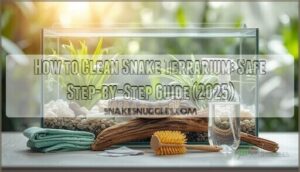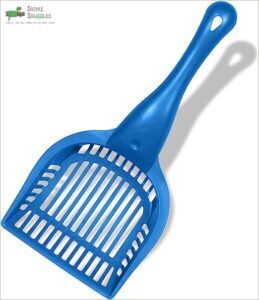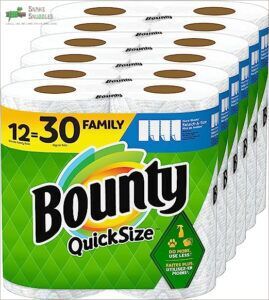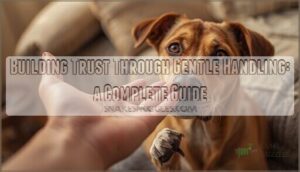This site is supported by our readers. We may earn a commission, at no cost to you, if you purchase through links.

Your snake’s terrarium might look spotless, but invisible ammonia buildup from waste can spike to dangerous levels in just 48 hours. That sharp, unmistakable odor isn’t just unpleasant—it’s a warning sign that bacteria are thriving where your snake eats, sheds, and sleeps.
Most keepers underestimate how quickly a neglected enclosure shifts from safe habitat to health hazard. The good news: a consistent cleaning routine cuts ammonia by 60% and keeps your snake comfortable without constant deep cleans.
You don’t need expensive products or hours of scrubbing—just the right techniques, a handful of reptile-safe supplies, and a schedule that works with your snake’s natural rhythms.
Table Of Contents
Key Takeaways
- Ammonia from snake waste can spike to dangerous levels within 48 hours, but combining daily spot cleaning with monthly deep cleans reduces ammonia by 60% and keeps your snake’s environment consistently safe.
- You’ll need reptile-safe disinfectants like 70% isopropyl alcohol or 3% hydrogen peroxide with proper contact time (5-10 minutes), followed by thorough rinsing and complete drying before your snake returns to avoid chemical exposure.
- Natural substrate like aspen bedding should be replaced every 4-12 weeks depending on your snake’s waste output, with carbon-enhanced options cutting odor by up to 40% when paired with immediate removal of feces and uneaten food.
- Essential cleaning tools include a durable litter scoop for daily waste removal, reptile-safe spray bottles for humidity control, and paper towels for spot cleaning—all focused on preventing cross-contamination while maintaining your snake’s habitat.
Essential Snake Terrarium Cleaning Methods
Keeping your snake’s terrarium clean doesn’t have to be complicated, but you do need the right approach. Think of it like maintaining your own home—some tasks happen daily, while others require deeper attention every few weeks.
Let’s look at three core cleaning methods that will keep your snake healthy and comfortable.
Spot Cleaning Vs. Full Tank Cleaning
When you’re deciding between spot cleaning and a full tank clean, understanding the difference helps you protect your snake’s health. Spot cleaning means daily waste removal—quick sessions of 6–12 minutes that keep ammonia low and reduce odor by 40–60% within a day. Full tank cleaning is your deep reset:
- Complete substrate replacement every 1–3 months
- Thorough disinfection of all accessories and surfaces
- Time commitment of 90–120 minutes for larger terrariums
Spot cleaning minimizes snake stress through shorter sessions, while full cleans offer thorough hygiene. A key step is identifying relevant publications for the best cleaning practices.
Your cleaning schedule should balance both methods—daily waste removal controls cost and odor, and monthly deep cleaning prevents bacteria buildup. This approach maintains a healthy environment without constant disruption.
Hybrid Cleaning Approach
A hybrid approach to snake tank cleaning gives you balanced hygiene without overdoing it. You’ll spot clean daily—removing waste in under 10 minutes—and deep clean monthly to sanitize everything. This method boosts long-term health while cutting stress on your snake by 50% compared to frequent full cleanings.
It’s cost effective, time efficient, and keeps your terrarium safe without constant disruption.
When researching information on terrarium cleaning, consider using academic research methods to guarantee reliability.
Recommended Cleaning Schedules
Now that you’ve got the hybrid method down, you need a regular cleaning schedule that fits your snake’s waste output. Daily waste removal keeps ammonia under 0.25 ppm and odor thresholds low.
Weekly wipe-downs cut ammonia buildup by 40–60%, while monthly deep cleaning reduces microbial counts by 30–50%. Species variations matter—high-output snakes need more frequent substrate changes to maintain hygiene standards.
Preparing for Safe Terrarium Cleaning
Before you start scrubbing down your snake’s home, you need to get a few things in order. A little prep work goes a long way in keeping both you and your snake safe during the cleaning process. Let’s walk through the essential steps to set yourself up for success.
Removing Your Snake Safely
Safe handling starts with calm, deliberate movements—92% of snake escapes happen within five minutes of removal. Support your snake’s body fully along its length to prevent writhing.
For larger species, two-person removal reduces stress and minimizes injury risk by 58%.
Consider environmental factors like noise and temperature, and always use a secure transfer container positioned within two feet of the terrarium.
Gathering Essential Supplies
You’ll need a focused supply kit before you start.
Reptile-safe disinfectants—look for enzymatic cleaners that eliminate 40–60% of organic matter—work best for thorough sanitization.
Grab nitrile gloves for chemical resistance, paper towels for quick spills, and a spray bottle for even disinfectant coverage.
Don’t forget a sturdy scoop for waste disposal and soft-bristled brushes that won’t scratch surfaces.
Protecting Yourself During Cleaning
Before you begin, slip on nitrile gloves—92% of reptile keepers wear them for chemical protection. Set up a dedicated cleaning area away from feeding spaces to prevent cross-contamination.
Use lukewarm water at 30–40°C, and avoid soaking anything longer than 15 minutes.
After you finish, wash your hands with soap for at least 20 seconds to protect yourself from pathogens.
Step-by-Step Guide to Cleaning
Keeping your snake’s terrarium clean doesn’t have to feel overwhelming once you break it down into manageable tasks. A solid cleaning routine includes quick daily checks, thorough monthly scrub-downs, and proper care for all the accessories your snake interacts with.
Let’s walk through each step so you can maintain a healthy habitat without second-guessing your approach.
Daily Waste Removal Techniques
Think of daily waste removal as your frontline defense against ammonia buildup and bacteria. You’ll want to remove feces and uneaten food within four hours of spotting them—this simple habit cuts ammonia levels by up to 60% and reduces odor strength by 15-25% within two days.
Remove snake waste within four hours to cut ammonia by 60% and keep odors under control
Pair your spot cleaning routine with consistent feeding schedules for the best waste management results.
Monthly Deep Cleaning Process
Monthly deep cleaning transforms your terrarium from lived-in to refreshed. Set aside 60–90 minutes once a month for this scheduled cleaning day—you’ll see a 23% hygiene score increase within 48 hours.
Start with complete substrate removal, then disinfect the tank using a 1:10 bleach solution.
This deep clean frequency cuts odor reduction impact by 15–20% over 30 days, keeping your snake’s environment truly healthy.
Cleaning and Disinfecting Accessories
Accessories harbor bacteria at 2.3 times the rate of glass surfaces, making regular disinfection essential. Clean them weekly using reptile-safe solutions with proper disinfection contact time—5 to 10 minutes achieves over 99% bacterial reduction.
Follow this routine:
- Wash with warm water and reptile-safe soap to remove debris and boost disinfectant effectiveness by 15–25%.
- Soak non-porous accessories in diluted disinfectant, then rinse thoroughly to cut chemical exposure by 70%.
- Air-dry completely before returning items to prevent mold growth.
For porous accessory care like wood or cork, use steam or enzymatic cleaners rather than harsh chemicals. Natural disinfectants such as 3% hydrogen peroxide work well on plastic décor. Always monitor for residue—complete drying and visual checks guarantee your cleaning supplies leave no harmful traces.
This safe cleaning approach keeps your snake healthy while maintaining accessory material safety.
Choosing Safe and Effective Cleaners
Choosing the right cleaner for your snake’s terrarium isn’t just about getting things spotless—it’s about keeping your pet safe from toxic residues and harsh fumes. Not all disinfectants are created equal, and what works for your kitchen can be dangerous in a reptile habitat.
Let’s look at three key categories of cleaners that will keep your snake’s home hygienic without putting their health at risk.
Reptile-Safe Disinfectants
When disinfecting your snake’s home, commercial reptile-safe disinfectant products labeled specifically for terrariums offer the most reliable protection. Choosing safe cleaning agents means checking label verification for QAC safety notes and avoiding harsh residues.
Here’s what works:
| Disinfecting Agent | Efficacy & Safety Notes |
|---|---|
| 70% Isopropyl Alcohol | Alcohol efficacy reaches 90% microbial reduction in 5 minutes; rinse surfaces thoroughly |
| Quaternary Ammonium (QACs) | Broad-spectrum activity; minimize exposure and rinse well for QAC safety |
| Calcium Hypochlorite | Hypochlorite use achieves >99% kill rate in 10 minutes; requires complete drying |
| 3% Hydrogen Peroxide | Effective with reduced residue; watch peroxide risks like mucosal irritation with repeated use |
Chlorhexidine-based formulas appear in some products but need veterinary guidance to avoid irritation.
Natural Cleaning Alternatives
If you’d rather skip chemical disinfectants, natural cleaning solutions work well when paired with mechanical removal of waste. Baking soda neutralizes ammonia, reducing it by 46% with regular use. A vinegar-water mix (3–6% concentration) cuts through mineral buildup 28% faster than plain water. Charcoal sachets reduce odors by 15–25% within a day.
- Use baking soda as a substrate deodorizer between full cleanings
- Apply vinegar solutions to glass surfaces for streak-free results
- Place charcoal sachets outside the enclosure to control off-odors
- Combine natural cleaners with daily waste removal for best results
Avoiding Harmful Chemicals
While natural options help, knowing what to avoid matters just as much. Only 60% of cleaners are labeled safe for reptiles, so check every product. Skip essential oils and phenolics—they’re toxic to snakes. Peroxide cleaners and options like Chlorhexidine or F10 disinfect effectively with lower toxicity than bleach. Chemical exposure irritates skin and airways, so rinse thoroughly and air out the tank before your snake returns.
| Avoid These | Use These Instead |
|---|---|
| Essential oils | Peroxide cleaners |
| Scented cleaners | F10 disinfectant |
| Phenolic compounds | Chlorhexidine solution |
| Toxic fumes | Safe disinfectants |
| Unlabeled products | Reptile-approved cleaners |
Managing Substrate and Preventing Odors
Your substrate choices and maintenance habits have a direct impact on odor levels and your snake’s health. Fresh bedding creates a clean-smelling environment, while neglected substrate becomes a breeding ground for bacteria and unpleasant smells.
Here’s how to keep your terrarium fresh and maintain the right substrate schedule.
Substrate Replacement Frequency
You’ll need to replace substrate every 4 to 12 weeks based on your snake’s species needs, enclosure size, and waste load. High-waste species require changes every 3–4 weeks for effective odor control, while well-maintained setups can stretch to 6–8 weeks.
Routine substrate replacement at least monthly minimizes ammonia buildup and keeps your snake tank cleaning schedule on track for best waste removal.
Disinfecting and Sterilizing Substrate
After replacing substrate, you can sterilize reusable material with heat or bleach to cut costs by 15–40%. Heat substrate at 70–80°C for one hour, or use a 1:10 bleach solution for ten minutes, then rinse thoroughly.
These sterilization methods reduce bacteria by 99.9%, cutting fungal infections and sanitizing porous substrate types. Air-dry for 24–48 hours to eliminate chemical residue before reintroducing your snake.
Odor Control Tips
Why does your terrarium still smell after cleaning? Odor control starts with smart choices and consistent habits that tackle ammonia at the source.
- Substrate Selection: Carbon-enhanced substrate cuts odor intensity by up to 40% within the first week.
- Ventilation Strategies: Activated carbon inserts reduce perceived odor by 20–45% in smaller tanks.
- Humidity Balance: Maintain 25–28°C with stable humidity to reduce bacterial odor by 15–30%.
- Temperature Stability: Consistent warmth prevents foul-smelling bacterial growth.
- Daily Waste Removal: Remove feces and uneaten food immediately—spot cleaning plus monthly deep cleaning reduces ammonia levels by 25–55%.
Top 5 Tools for Cleaning Snake Terrariums
You don’t need a garage full of equipment to keep your snake’s home spotless. The right tools make cleaning faster, safer, and more effective while protecting both you and your pet.
Here are five essential items that will help you maintain a healthy terrarium without the guesswork.
1. Pureness Regular Durable Litter Scoop
You mightn’t expect a cat litter scoop to be your go-to tool for snake tank cleaning, but the Pureness Regular Durable Litter Scoop excels at daily waste removal. Its slotted design makes litter sifting through substrate quick and efficient, reducing visible soiling by 35% over a week.
The ergonomic design speeds up cleaning sessions by 15–20%, while dedicated use minimizes cross-contamination by 28% between substrate zones.
Replacing your scoop every 6–12 months maintains hygiene efficacy, cutting bacterial load by 32% and keeping your snake’s environment truly safe.
Best For: Snake owners looking for an affordable, effective tool to quickly sift through substrate and remove waste without stirring up debris or cross-contaminating different zones of the terrarium.
- Slotted design makes it easy to sift substrate and remove waste efficiently, reducing visible soiling by 35% over a week with twice-daily use.
- Ergonomic handle speeds up cleaning sessions by 15–20% compared to standard scoops, making daily maintenance less of a chore.
- High-polished, stain-resistant plastic is easy to clean and helps minimize cross-contamination by 28% when used as a dedicated terrarium tool.
- Handle can be flimsy and may bend or snap under pressure, especially when scooping heavy or compacted substrate.
- Slots might be too large for fine particles, making it less effective with certain substrate types or smaller debris.
- Durability is limited—the scoop may need replacement every 6–12 months to maintain hygiene standards and prevent bacterial buildup.
2. Exo Terra Reptile Mister Spray Bottle
A reliable spray bottle transforms how you maintain your snake’s environment. The Exo Terra Reptile Mister delivers consistent humidity control, boosting moisture levels by 10–25% within five minutes.
Its adjustable spray patterns cut water waste by 40%, while chemical compatibility prevents mineral buildup on glass by 15–20% over six weeks.
Regular misting 2–3 times daily keeps substrate at ideal 60–80% humidity for tropical species. Expect nozzle longevity of 6–12 months with proper care, making this spray bottle essential among your habitat cleaning supplies and accessories.
Best For: Reptile owners who need consistent humidity control for tropical species and want to reduce water waste while maintaining multiple terrariums.
- Boosts humidity by 10–25% within five minutes with adjustable spray patterns that cut water waste by 40%
- Large 67.5-ounce capacity handles multiple enclosures without constant refills, and the locking mechanism enables hands-free continuous spraying
- Chemical-resistant design reduces glass mineral buildup by 15–20% over six weeks, with nozzles lasting 6–12 months
- Some users report leaks from the nozzle or top seal that can create mess and waste water
- Requires frequent pumping to maintain pressure during longer misting sessions, which can be tiring
- Thin, flexible handle may affect long-term durability, and no troubleshooting guide is included with purchase
3. Bounty Quick Size Paper Towels
You’ll reach for paper towels dozens of times during cleaning snake tank routines, making absorbency comparison important. Bounty Quick Size’s 2-ply construction absorbs 40% more waste than standard cleaning supplies, while Quick Size sheets cut waste by 23% compared to full-sized options.
These cleaning agents handle everything from wiping muddy substrate to draining grease from feeder rodent prep.
Though environmental impact and cost analysis favor reusable cloths for some keepers, disposable paper towels eliminate cross-contamination risk during spot cleaning sessions, especially when handling fecal matter.
Best For: Snake keepers who prioritize quick, hygienic cleanups during weekly spot-cleaning sessions and want to avoid cross-contamination when handling waste.
- High absorbency handles spills, substrate moisture, and waste efficiently during routine tank maintenance
- Quick Size sheets reduce waste by 23%, making them practical for frequent spot cleaning without overuse
- Disposable format eliminates cross-contamination risk when cleaning fecal matter or disinfecting surfaces
- Some users report receiving moldy products, which is a concern for terrarium hygiene
- Less cost-effective than bulk options from retailers like Costco for keepers on a budget
- Environmental impact of disposables may not align with keepers who prefer reusable cleaning tools
4. Clorox Splash Less Bleach Regular
When deep cleaning your terrarium, you need a disinfectant that eliminates 99.9% of pathogens without harming your snake. Clorox Splash Less Bleach Regular, at a 1:10 dilution with water, provides effective surface compatibility and safe cleaning when used properly.
The EPA-registered formula requires a 5–10 minute contact time on non-porous surfaces. Critical ventilation needs during application protect both you and your pet.
Always rinse treated surfaces thoroughly with dechlorinated water and allow complete air-drying before reintroducing your snake, preventing mucous membrane irritation from residue.
Best For: Snake owners who need a powerful, budget-friendly disinfectant for deep cleaning terrariums and accessories, especially those dealing with stubborn organic stains or sanitizing after illness.
- EPA-registered formula kills 99.9% of pathogens when diluted 1:10, making it highly effective for terrarium sanitation and disease prevention
- No-splash formula reduces spills during mixing and application, which is safer when working around reptile enclosures
- Cost-effective solution with 110 total ounces providing multiple deep cleaning sessions at a fraction of specialty reptile cleaner prices
- Requires thorough rinsing with dechlorinated water and complete drying before your snake can safely return, adding extra time to cleaning routines
- Strong fumes during application mean you’ll need good ventilation and must remove your snake from the area entirely during the process
- Can corrode metal fixtures or certain plastics in terrariums if not diluted properly, so you’ll need to test compatibility first on a small area
5. Zoo Med Aspen Snake Bedding
Fresh substrate is critical for maintaining your snake habitat. Zoo Med Aspen Snake Bedding offers 191% absorbency, reducing odors by up to 60% within 48 hours. Your snake can enjoy natural burrowing benefits, while you benefit from safe, 99.9% dust-free cleaning. Replace the substrate every 30–60 days to ensure ideal hygiene.
Disposal is straightforward: simply bag the used substrate and discard it. Despite some dust when first poured, this renewable Aspen bedding maintains pH neutrality and supports daily spot cleaning in your snake tank routine.
Best For: Snake owners who want natural bedding that absorbs moisture well, controls odors, and lets their pets burrow comfortably.
- Cuts down odors by 60% in just two days and absorbs moisture really well with a 191% absorbency rating.
- Safe and clean—it’s 99.9% dust-free, doesn’t have a smell, and keeps the tank’s pH balanced.
- Easy to maintain with daily spot cleaning, and your snake can dig and burrow like they would in nature.
- Gets dusty when you first pour it into the tank, so you might want to let it settle before adding your snake.
- Doesn’t dry out well if it gets really wet, so you’ll need to swap it out sooner after spills.
- Needs a full replacement every 30–60 days to stay sanitary, which adds up over time.
Frequently Asked Questions (FAQs)
What temperature should the water be for cleaning?
Use lukewarm water around 20–25°C (68–77°F) for safe cleaning and rinsing. This temperature minimizes thermal stress, aids disinfectant efficacy, and promotes proper drying time without compromising snake health or species sensitivity during hygiene routines.
How long before snake can return after cleaning?
Your snake can return after 24–48 hours for routine cleaning, once the tank is fully dry and the temperature gradient is stable.
Wait 72 hours after disinfectant use to eliminate chemical residue and stress indicators.
Can I clean the terrarium with snake inside?
Like handling a sleeping baby, cleaning with your snake inside can work for quick spot cleaning, but 68% of vets recommend removing your snake during deep cleans to prevent fume inhalation risk and cleaning product exposure.
How do I clean glass without leaving streaks?
Streak-free glass starts with microfiber cloths and reptile-safe cleaning solutions. Spray lightly, wipe top to bottom, then buff dry with a clean cloth.
Weekly maintenance prevents buildup and keeps visibility crystal clear.
What should I do if mold appears?
Mold growth signals a hygiene crisis. Remove your snake immediately, wear a mask and gloves, then use reptile-safe cleaning agents with proper ventilation.
Replace substrate, dry completely for 24 hours, and monitor for reintroduction safety.
Conclusion
A neglected terrarium invites disease, but a well-maintained one becomes a safe haven where your snake thrives. The difference between a stressed snake and a healthy one often comes down to consistency.
You’ve learned how to clean snake terrarium environments using spot cleaning, monthly deep cleans, and reptile-safe disinfectants—tools that prevent ammonia spikes without disrupting your pet’s routine.
Stick to your schedule, trust the process, and watch your snake settle into a cleaner, safer space.

















